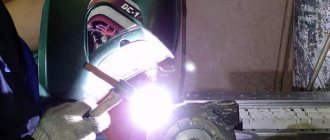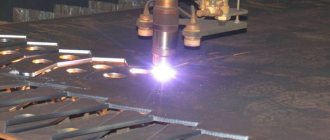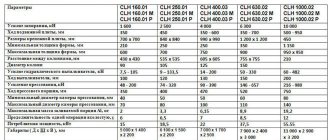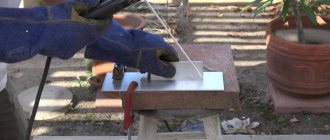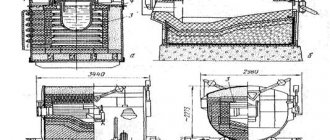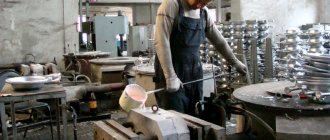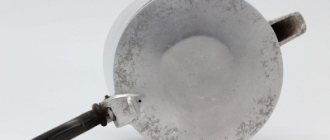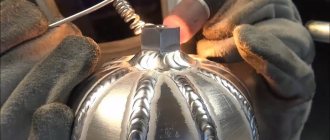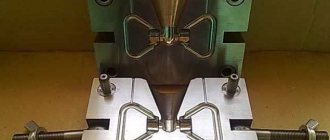The need for welding work often arises not only in production, but also in everyday life. Welding of aluminum products and structures at home is carried out quite often, despite the occurrence of some difficulties. The difficulties are due, first of all, to the characteristics that this material has. the conditions necessary for working with aluminum .
However, situations arise when it is necessary to repair aluminum products. In such cases, the work is performed at home, by the contractor’s independent efforts. Therefore, in this article we will look at the main features and nuances of aluminum welding.
Aluminum alloys - what types of welding are there?
Aluminum alloys
What you need to know about aluminum alloys is that they have different compositions and can oxidize quickly. The oxides that coat the surface with a film are difficult to remove, and they themselves turn out to be a serious obstacle to joining the workpieces. In order for the welding process to proceed successfully, a certain environment is required that prevents the oxidation of the metal, and a flux that removes the film. The protective medium is usually the inert gas argon.
Another feature of aluminum alloys is the high expansion coefficient of the metal. When cooling, the weld undergoes deformation, distorting the shape of the resulting product. Therefore, for thin workpieces, a seam that is too thick should not be used.
The following basic welding methods for joining aluminum alloys can be distinguished:
- MMA method - the use of special consumable coated electrodes under the influence of direct current of reverse polarity;
- AC TIG method using refractory tungsten electrodes, melting from an alternating high-frequency current in an inert gas;
- MIG welding method using a semi-automatic machine in an argon environment using aluminum wire.
Preparing parts
The use of any aluminum welding method requires careful preparation and processing of the part, even if it is necessary to weld a small crack. First of all, mechanical cleaning of dirt deposits, industrial fats, oils and other things is necessary. After this, the part must be degreased. You can use jet fuel, white spirit, acetone or other solvents with similar properties.
After this, the parts must be brightened for several minutes in a solution of nitric acid at room temperature. Its concentration must be at least 350 g/l. When thick parts are to be welded, their edges need to be cut. When using electrodes with a special coating - if the thickness exceeds 20 mm, with other methods - more than 4 mm.
When welding thin aluminum sheets or profiles (no more than 1.5 mm thick), the ends must be beaded.
One of the most important preparatory steps is removing the aluminum oxide film. For this purpose, it is best to use a scraper or brush with stainless wire hairs. Do not use abrasive wheels, sanding belts, sandblasting or shot blasting machines due to the high likelihood of slag deposits. From the moment the preparatory work is completed until the parts are welded, no more than 3-4 hours should pass.
What are the advantages of welding aluminum at home?
For those who have an understanding of the steel welding process, it is not difficult to master the skill of joining aluminum structures in a similar way. This will make it possible:
- Do not waste extra time searching for qualified specialists;
- Refuse to order expensive workshop services;
- Expand your professional abilities by providing services;
- Be more independent when choosing materials for making products.
Aluminum welding technology
Process Features
The surface of aluminum parts is covered with an oxide film, which has high chemical resistance, as well as a melting point 2 times higher than pure metal. In the range from +2500С to +3000С aluminum becomes unstable and melts. The minimum melting temperature of the oxide film is +5000C.
When soldering, the parts being connected under the outer layer begin to melt. Therefore, the shareholder needs to eliminate the negative impact of the oxide layer. The principle of all methods is based on film removal, as well as increasing adhesive properties.
Methods for removing the oxide layer:
- mechanical - the use of abrasive tools for stripping;
- chemical - the use of fluxes with special compositions;
- electrochemical - based on electrolysis processes.
Both methods are carried out only in an environment without oxygen.
What methods are used to weld aluminum at home?
Without resorting to purchasing expensive equipment in a home workshop, you can join aluminum alloys. Unlike steel parts, great dexterity and speed of action are required here, since metal has exceptionally good thermal conductivity, and under the influence of high temperatures it can easily leak, making it difficult to maintain an even seam. All this is taken into account when choosing a welding method.
Welding aluminum with an electrode at home
The method is simple, very similar to conventional electric welding on a machine. In this case, it is quite difficult to obtain a good seam due to the low viscosity of the material. The solidity of the connection also leaves much to be desired. You can work with not very critical areas and elements. Welding in this way is possible for craftsmen who have at least a little experience in this matter.
Table of characteristics of electrodes for aluminum welding
Welding with a gas torch
Achieving the melting temperature of the metal and the ability of the sections to weld with each other is achieved here through gas combustion. At the same time, the speed of welding aluminum at home drops three times, which allows you to more successfully control it and obtain a clearer seam. Welded aluminum wire is used as a connecting element. The gas protects the connection areas of the elements more reliably than the special coating on the electrodes for aluminum alloys.
Welding aluminum with a gas torch
Tig welding
This is the best option for joining workpieces made of aluminum-based alloys. Its effectiveness lies in the fact that a melting arc is used, and protection against oxides is carried out with argon gas. The electrode itself is not subject to melting. It melts a special filler wire connecting the heated working areas of the parts. The seam turns out clear, even, without sagging or drips.
It is difficult to use this method at home; special equipment is required.
Diagram of a TIG machine for argon arc welding
Preparatory stage
Before starting the actual process of soldering aluminum, it is necessary to prepare the workplace, tools and the material itself:
Scheme of preparation for soldering aluminum
- Preparing the workplace comes down to removing unnecessary items, especially when using a gas torch or blowtorch.
- The workpieces must be securely fastened in yews or clamps.
- Tools are located in easily accessible places at arm's length.
- Solder must be prepared in sufficient quantities to prevent interruption of the soldering process to find and deliver it.
- Aluminum blanks in the soldering areas are cleaned with sandpaper or a file, and then degreased with acetone or gasoline.
- When working with large parts, the joints will have to be heated using an open fire, so special attention should be paid to observing fire safety measures.
Purpose of the sponge during soldering
Tools and material for work
The MMA method is the most affordable in terms of the necessary tools for welding aluminum at home. The basis here is the welding machine. It is more convenient to use an inverter-type device than a conventional welded transformer, which does not have the ability to be adjusted. All you need is:
- Inverter device for MMA with grounding bus, cable and holder;
- Welded electrodes for aluminum and alloys, coated with a special coating;
- Welder protective mask;
- File and wire brush;
- Flux, solvent;
- Hammer, pliers, grinder.
You need to have more professional and expensive equipment to weld aluminum yourself using argon (TIG method). A significant advantage of the method is that there are no restrictions on the thickness and type of aluminum alloys. To work you will need:
- Inverter design device for MMA plus TIG;
- Automatic gas supply system;
- Tungsten electrode holder built into the torch;
- Pressure control gauges and gas supply reducer;
- Connecting hoses;
- Aluminum welded wire with flux and additives;
- Gaiters and welder's protective mask.
Diagram and essence of the TIG welding process
To weld aluminum at home using the MIG method, which uses melting wire, you must have a special automatic feeder to the area where the elements are connected. The design of the burner here should be such as to melt the retractable wire. You should also have:
- Means of fixing and holding the parts to be joined - vices, clamps, pliers;
- A tool for cleaning the surface from oxides - a metal brush, a file;
- Protective clothing made of cotton fabric, mittens, mask with light-limiting glass.
MIG welding diagram
Necessary equipment
It is logical that to carry out work of this kind, the use of equipment is mandatory. First of all, it is necessary to ensure suitable conditions and prevent the occurrence of traumatic situations.
Moreover, it is necessary that this equipment helps control the energy transformation process.
For welding using gas, you will need an element with a gas supply, a cylinder with the necessary gas, a reducer and gas hoses.
Special coated electrodes
When there are no special requirements for welding aluminum at home in terms of the strength and reliability of the weld, it is advisable to use special electrodes for working with aluminum. They have a coating that performs a protective function against oxidation and acts as a flux. The method is not suitable for connecting parts whose working surface is less than four millimeters.
Electrodes of the OZANA and UANA brands can be used to weld pure technical aluminum and alloys. Seam quality indicators:
- Low strength;
- The presence of pores and shells;
- Contamination with slags that are difficult to remove.
Safety precautions
This type of activity belongs to the group of trauma-hazardous processes. Therefore, you should strictly follow the prescribed rules to avoid causing harm to others.
It should be remembered that:
- The specialist must wear: a special suit, a mask, thick gloves, shoes with rubber soles;
- The electrical circuit must be isolated and inaccessible;
- Welding can only be carried out in clean areas. It is prohibited to carry out work in the presence of flammable objects;
- The work area must have good ventilation to avoid gas poisoning.
Soldering methods
There are the following soldering methods:
- with rosin;
- with solder;
- electrochemical.
With rosin
Step-by-step implementation of the method:
- The soldering iron is warming up.
- The tip is tinned to remove dirt or carbon deposits.
- Rosin is applied to the joint seam and melted with a soldering iron.
- After melting, use a sting to rub the surface until the oxide film is removed. At the same time, tinning occurs.
- After the process is completed, the elements are joined, heated to the melting point, and then left to cool.
Using solders
The method using solder for soldering aluminum is implemented as follows:
- The joining surfaces are cleaned mechanically.
- The parts are securely fixed.
- Local heating of the structure is performed.
- The rod with solder is guided along the joint seam, simultaneously heating it with a burner until it melts.
If solder without flux is used, it will need to be used separately. It is pre-applied in an even layer on aluminum.
Electrochemical method
Step-by-step electrochemical soldering of aluminum:
- The surface is cleaned of dirt, partly of the oxide film, mechanically.
- Apply a thin layer of copper sulfate.
- The negative electrode of the current source is connected to the part.
- The positive electrode is connected to a high purity copper wire (diameter greater than 1 mm). It is located above the structure on a special stand, ensuring contact only with the treated area.
- The power source turns on. The electrolysis process begins to take place.
- After removing the oxide film, the wire is removed, and the parts are heated with a soldering iron to the melting temperature or solder is used.
To ensure high quality soldering, it is necessary to apply galvanic coatings with special tools. They will allow for uniform copper plating.
Copper sulfate
